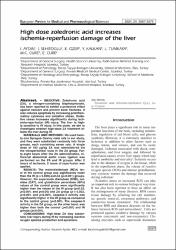| dc.contributor.author | Aydın, İbrahim | |
| dc.contributor.author | Şehitoğlu, İbrahim | |
| dc.contributor.author | Özer, Emel | |
| dc.contributor.author | Kalkan, Yıldıray | |
| dc.contributor.author | Tümkaya, Levent | |
| dc.contributor.author | Cüre, Medine Cumhur | |
| dc.contributor.author | Cüre, Erkan | |
| dc.date.accessioned | 2022-10-07T07:31:43Z | |
| dc.date.available | 2022-10-07T07:31:43Z | |
| dc.date.issued | 2021 | en_US |
| dc.identifier.citation | Aydin, I., Sehitoglu, I., Ozer, E., Kalkan, Y., Tumkaya, L., Cure, M. C., & Cure, E. (2021). High dose zoledronic acid increases ischemia-reperfusion damage of the liver. European review for medical and pharmacological sciences, 25(9), 3567–3575. https://doi.org/10.26355/eurrev_202105_25839 | en_US |
| dc.identifier.issn | 1128-3602 | |
| dc.identifier.uri | https://doi.org/10.26355/eurrev_202105_25839 | |
| dc.identifier.uri | https://hdl.handle.net/11436/6676 | |
| dc.description.abstract | OBJECTIVE: Zoledronic acid (ZA), a nitrogen-containing bisphosphonate, has been reported to exhibit a protective effect against cancers and prevent bone fractures. It also induces apoptosis by increasing proinflammatory cytokines and oxidative stress. Oxidative stress increases significantly during ischemia-reperfusion (IR) injury. The liver is highly sensitive to IR injury. In this study, we aim to investigate whether high-dose ZA treatment affects the liver during IR.
MATERIALS AND METHODS: We used twenty-one Sprague-Dawley male rats in our study. and they were subdivided randomly into three groups, each containing seven rats. A single dose of 100 pg/kg ZA was administered via the intraperitoneal route in the ZA group. Forty-eight hours after the ZA administration, infrarenal abdominal aortic cross ligation was performed on the ZA and IR groups. After 2 hours of ischemia, 2 hours of reperfusion was applied.
RESULTS: The malondialdehyde (MDA) level of the control group was significantly lower than the IR (p = 0.006) and ZA (p<0.001) groups. However, the superoxide dismutase (SOD), catalase (CAT), and glutathione peroxidase (GPx) values of the control group were significantly higher than the values of the IR group (p<0.05. p<0.001, and p<0.05) and ZA group (p = 0.002, p<0.001, and p<0.001). Caspase-3 activity was significantly higher in the IR group as compared to the control group (p<0.001). The caspase-3 activity in the ZA group, on the other hand, was higher than both the control (p<0.001) and IR groups (p<0.001).
CONCLUSIONS: High-dose ZA may exacerbate liver injury during IR by increasing reactive oxygen species production and apoptosis. | en_US |
| dc.language.iso | eng | en_US |
| dc.publisher | Verduci Publisher | en_US |
| dc.rights | info:eu-repo/semantics/openAccess | en_US |
| dc.subject | Zoledronic acid | en_US |
| dc.subject | Ischemia-reperfusion injury | en_US |
| dc.subject | LiverCaspase | en_US |
| dc.title | High dose zoledronic acid increases ischemia-reperfusion damage of the liver | en_US |
| dc.type | article | en_US |
| dc.contributor.department | RTEÜ, Tıp Fakültesi, Cerrahi Tıp Bilimleri Bölümü | en_US |
| dc.contributor.institutionauthor | Şehitoğlu, İbrahim | |
| dc.contributor.institutionauthor | Kalkan, Yıldıray | |
| dc.contributor.institutionauthor | Tümkaya, Levent | |
| dc.identifier.doi | 10.26355/eurrev_202105_25839 | en_US |
| dc.identifier.volume | 25 | en_US |
| dc.identifier.issue | 9 | en_US |
| dc.identifier.startpage | 3567 | en_US |
| dc.identifier.endpage | 3575 | en_US |
| dc.relation.journal | European Review for Medical and Pharmocological Sciences | en_US |
| dc.relation.publicationcategory | Makale - Uluslararası Hakemli Dergi - Kurum Öğretim Elemanı | en_US |


















